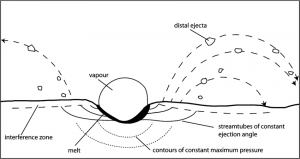One of the most characteristic, but poorly understood, aspects of the impact cratering process is the generation of ejecta deposits. The lack of understanding is due, in part, to the scarcity of ejecta at the majority of the known terrestrial impact structures. Observations of impact ejecta deposits on other planetary bodies provide a complementary data set with which to study the emplacement of impact ejecta. Understanding the mechanism of impact ejecta generation and emplacement is important as these deposits provide a natural method to sample the subsurface (material beneath the surface) of planetary bodies. It is, therefore, critical to understand the depth of origin of ejecta materials from any particular impact site.

Cross-section illustration of material being ejected from the focal point of a meteoritic impact. Credit: modified from Melosh (1984) from Buchner et al., (2007).
Proximal ejecta deposits are rare on Earth due to post-impact erosional processes, but are common on other planetary bodies. It is generally accepted that proximal ejecta deposits on airless bodies, such as the Moon, are emplaced via ballistic sedimentation. In this model, the ballistic emplacement of primary crater-derived ejecta results in secondary cratering and the incorporation of local material (so-called “secondary ejecta”), and considerable modification of the local substrate.
References
- Buchner, Elmar & Graesslin, Michael & Maurer, Holger & Ringwald, H. & Schöttle, U. & Seyfried, Hartmut. (2007). Simulation of trajectories and maximum reach of distal impact ejecta under terrestrial conditions: Consequences for the Ries crater, southern Germany. Icarus. 191. 360-370. 10.1016/j.icarus.2007.04.016.
- Melosh, Jay. (1984). A Speed Limit for Impact-Ejected Spalls. 15. 538-539.
